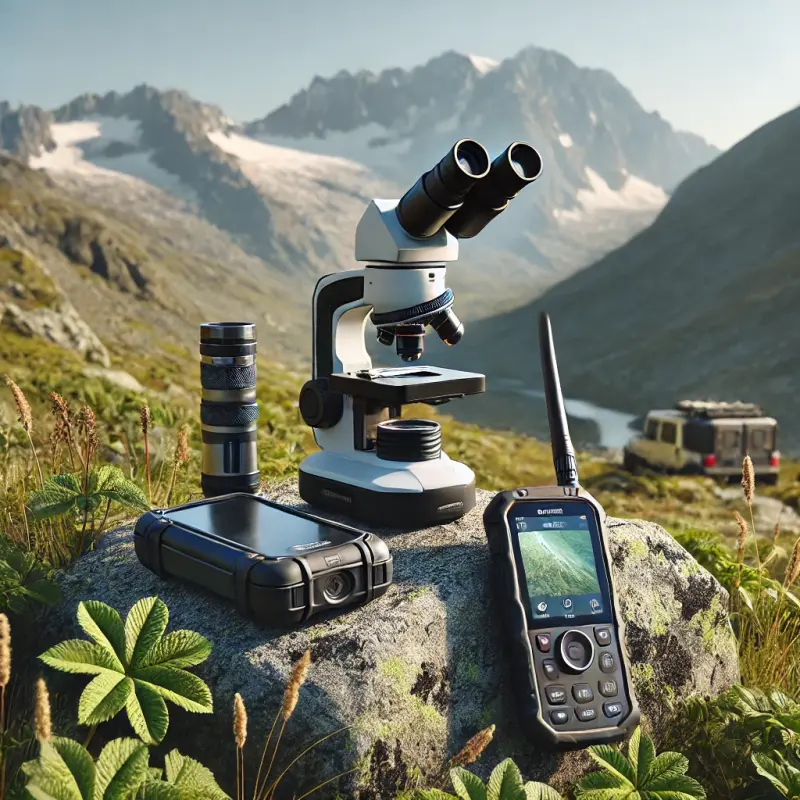Gadgets for High-Altitude Flora Research: How Technology Assists Botanists

High-altitude ecosystems are home to some of the most unique and resilient plant species on Earth. However, studying flora in these challenging environments presents significant difficulties, including harsh weather conditions, remote locations, and limited accessibility. Fortunately, technological advancements have introduced innovative gadgets that enable botanists to conduct precise and efficient research at high altitudes.
This article delves into the essential gadgets used for studying alpine plants, exploring how these tools enhance botanical research and contribute to a better understanding of these fragile ecosystems.
Challenges of Researching High-Altitude Flora
Studying plants at high altitudes involves overcoming several obstacles:
- Extreme Conditions: Low temperatures, strong winds, and intense UV radiation can hinder research activities.
- Limited Access: Remote and rugged terrains make it difficult to transport traditional equipment.
- Short Growing Seasons: Alpine plants often have brief flowering periods, requiring efficient data collection during limited timeframes.
- Biodiversity Preservation: Researchers must minimize their ecological footprint to protect sensitive environments.
Technological innovations have addressed these challenges, providing botanists with lightweight, durable, and versatile tools for fieldwork.
Essential Gadgets for High-Altitude Botanical Research
1. Portable Microscopes
High-altitude plants often have unique structural adaptations to survive extreme conditions. Portable digital microscopes allow botanists to examine these features on-site without damaging the specimens. Features include:
- High Resolution: Captures microscopic details of plant cells and tissues.
- Lightweight Design: Easy to carry in rugged terrains.
- Digital Connectivity: Transfers images to smartphones or tablets for immediate analysis.
2. Rugged GPS Devices
Accurate geolocation is crucial for mapping plant populations and monitoring ecological changes over time. Rugged GPS devices offer:
- Durability: Resistant to water, dust, and shocks.
- Precision Mapping: Pinpoints exact locations of plant species.
- Data Storage: Records coordinates and environmental data for future reference.
3. Drone Technology
Drones equipped with advanced sensors and cameras provide aerial perspectives of high-altitude flora. Applications include:
- Vegetation Mapping: Identifies plant distribution and density.
- Climate Monitoring: Measures temperature, humidity, and other environmental factors.
- Hard-to-Reach Areas: Accesses remote or dangerous locations.
4. Plant Analyzers
Handheld plant analyzers use spectroscopy to measure chlorophyll content, photosynthesis rates, and water stress levels. Benefits include:
- Non-Destructive Testing: Gathers data without harming plants.
- Real-Time Results: Provides instant insights into plant health.
- Versatility: Suitable for diverse plant species.
5. Environmental Sensors
Compact environmental sensors monitor microclimatic conditions critical to plant survival. These devices measure:
- Temperature and Humidity: Tracks changes affecting plant growth.
- Soil Composition: Analyzes nutrient levels and moisture content.
- UV Radiation: Monitors exposure that impacts photosynthesis.
6. Digital Herbarium Apps
Mobile applications streamline the documentation process, allowing botanists to create digital herbarium records in the field. Features include:
- Photo Annotation: Captures images with detailed notes.
- Species Identification: AI-based tools recognize plant species from photographs.
- Cloud Storage: Safely stores data for collaborative research.
Benefits of Using Technology in High-Altitude Research
1. Increased Efficiency
Technological tools reduce the time and effort required for data collection, enabling researchers to cover larger areas and study more specimens.
2. Improved Accuracy
Advanced sensors and devices provide precise measurements, ensuring reliable results for ecological studies.
3. Environmental Conservation
Non-invasive gadgets help minimize disturbances to delicate alpine ecosystems.
4. Enhanced Collaboration
Digital tools facilitate data sharing among researchers worldwide, fostering collaboration and accelerating discoveries.
5. Long-Term Monitoring
Technological devices enable consistent tracking of environmental changes, aiding in the conservation of endangered plant species.
Case Studies: Technology in Action
1. Monitoring Climate Change Effects
In the Himalayas, researchers use drones and environmental sensors to study how rising temperatures impact plant distribution and phenology. Data collected has revealed shifts in flowering seasons and migration of species to higher altitudes.
2. Preserving Alpine Meadows
In the Andes, portable microscopes and plant analyzers are used to monitor the health of rare flowering plants. These tools help identify stress factors, guiding conservation efforts.
3. Mapping Endangered Species
In the Alps, botanists use rugged GPS devices and digital herbarium apps to map populations of endangered species. Accurate data supports habitat protection initiatives.
Challenges and Future Directions
Challenges
- High Costs: Advanced gadgets can be expensive, limiting accessibility for smaller research teams.
- Technical Training: Researchers must acquire skills to operate and maintain sophisticated devices.
- Environmental Impact: Battery-powered devices and drones must be used responsibly to avoid environmental harm.
Future Directions
- Integration with AI: Machine learning algorithms can analyze data collected from gadgets, identifying patterns and predicting ecological trends.
- Miniaturization: Developing lighter and more portable devices will enhance usability in rugged terrains.
- Renewable Energy Solutions: Solar-powered gadgets can reduce reliance on batteries, making technology more sustainable.
Conclusion
Gadgets for high-altitude flora research have revolutionized the way botanists study and protect fragile ecosystems. From portable microscopes to drones and plant analyzers, these tools provide invaluable support in overcoming the challenges of remote fieldwork. As technology continues to evolve, it will play an even greater role in advancing our understanding of alpine plants and ensuring their preservation for future generations.
By leveraging innovative solutions, botanists can uncover the secrets of high-altitude ecosystems, contributing to global efforts in biodiversity conservation and ecological sustainability.
Articles
Subscribe to our updates and receive the most recent and interesting articles directly in your inbox.